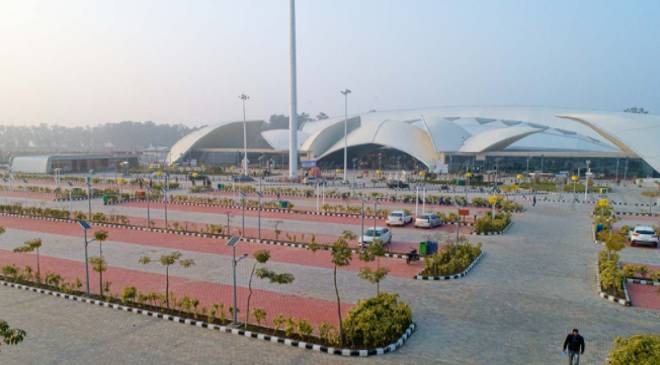Import, Export, Trade for MSMEs: Fast-tracked development of India’s land ports facilitates the trading environment for MSMEs, promotes bilateral relations with our neighbours, and sets benchmark for border efficiency.
By Nikita Singla
Import, Export, Trade for MSMEs: India has 109 border check posts with its immediate neighbours that form an integral part of its ‘Neighbourhood First’ and ‘Act East’ policies. Of these check posts, 11 are upgraded from a Land Customs Station (LCS) to an Integrated Check Post (ICP), housing customs, immigration authorities, border security forces, quarantine and recently sanctioned land port health units, together as single-window facilitation facility, for smooth cross-border movement of passengers and goods. Development of logistics infrastructure complemented with enabling policy and regulatory ecosystem holds significant potential towards making MSMEs more competitive.
Although trade between the BBIN (Bangladesh, Bhutan, India and Nepal) countries grew six-fold between 2005 and 2019 (pre-COVID), the unexploited potential remains massive, estimated by the World Bank at 93 per cent for Bangladesh, nine per cent for Bhutan, 50 per cent for India and 76 per cent for Nepal.
Read More: Short Video App Chingari Fires One-Fifth Of Its Employees Amid Organisational Restructuring
Within the BBIN countries, Petrapole-Benapole (along the India-Bangladesh border), Jaigaon-Phuentsholing (along the India-Bhutan border) and Raxaul-Birgunj (along the India-Nepal border) are the busiest trading points and as a result, also the focus of government efforts towards improving logistics and infrastructure. This is reflected in the fast-tracked development of ICPs at different land border crossings, led by the Land Ports Authority of India (LPAI), a statutory body working under the Ministry of Home Affairs. ICP development is driven, on the one hand, by India’s National Trade Facilitation Action Plan (NTFAP) commitment to bring down the import clearance time to within 48 hours and export clearance time to within 24 hours at land borders, and on the other hand, by India’s popular policies of Neighbourhood First and Act East.
To provide more context, India’s Central Board of Indirect Taxes and Customs (CBIC), under the Ministry of Finance, conducts annual time release studies at 15 ports in India, which includes two land ports – ICP Raxaul and ICP Petrapole. As per the findings of the National Time Release Study (NTRS) 2023, released last week, the import clearance time at these ICPs combined is 31 hours 47 minutes and the export clearance time is 11 hours 7 minutes. With this performance, both the ICPs have bettered the NTFAP targets stated above.
Although the share of trade through land ports in India’s overall trade is relatively low, it has a significant impact on the ecosystem surrounding the port. At a bilateral level, trade through land ports acts as a major confidence-building measure, encouraging constructive cross-border trading partnerships with MSMEs on both sides and at the local level, border trade helps in job creation and ancillary economic benefits.
Read More: PM Modi to Meet Elon Musk For First Time After His Twitter Takeover
Moreover, landlocked countries such as Nepal and Bhutan are completely dependent on India for their third-country trade. Such constraints further develop a strong case for the development of land ports, in the context of seeking greater efficiencies in managing trade and travel flows, while maintaining balance with the compliance requirements.
As an example, along the open border of 1,751 km between India and Nepal, 3 of the border check posts, namely Rupaidiha (Uttar Pradesh), and Raxaul and Jogbani (Bihar) have been operationalised as ICPs. More than 40 per cent of the bilateral trade (of over $9 billion) occurs through the Raxaul-Birgunj land port. ICP Raxaul, after being operationalised in 2016, has helped realise mutually beneficial people-to-people and economic trade ties between India and Nepal. India’s exports to Nepal increased by 76 per cent in 2016 with the operationalisation of ICP Raxaul.
It has been frequently reiterated that one of the most important non-physical barriers affecting the region’s integration through land transport is the delays at border crossings. With the development of ICPs, there is a continuous focus on addressing the infrastructural and operational constraints, along with a notable commitment to making land ports gender-sensitive. This complements well with recent initiatives at the local level, such as the Suvidha Pass Facilitation System, an initiative of the State of West Bengal, which streamlines the pre-arrival parking process through an online slot booking portal enabling entry into a land port, with the most significant impact seen in the case of ICP Petrapole.
But more needs to be achieved towards coordination and cooperation across the border, often termed Coordinated Border Management (CBM) in trade parlance.
According to the World Customs Organization, CBM involves agencies within the same country as well as coherent regulatory bodies across borders, striving to attain streamlined and effective regulatory processes by establishing official measures, mechanisms and communication channels. This also aligns with the vision of the Government of India as part of the National Trade Facilitation Action Plan, Action Point 10 which refers to exploring the feasibility of alignment of working days and hours, mutual recognition of testing, harmonisation of standards etc.
Through field visits to all the above-mentioned ICPs, it was observed that many of the land ports along the India-Bangladesh border have aligned on observing Friday as the weekly off on both sides. Also, there is mutual recognition of testing facilities wherein food testing laboratories of Bhutan, that is, the National Food Testing Laboratory (NFTL) and Bhutan Agriculture and Food Regulatory Authority (BAFRA) have been accredited by the Food Safety and Standards Authority of India (FSSAI), thus facilitating cross-border trade of food products and resulting in time and cost savings.
In some cases, there are regulatory bottlenecks that need intervention from the CBIC in India and equivalent counterparts in the neighbouring countries, such as the National Board of Revenue (NBR) in Bangladesh. One of these is the existence of a positive list of only 42 items that are allowed to be traded from India to Bangladesh via ICP Agartala-Akhaura, which should be replaced by a negative list, wherein all items are allowed for trade except those in the negative list.
With Nepal, the passage of the Plastic Waste Management Act by India in 2022, impacts the imports of commodities such as Dabur products containing single-use plastic in straws, stirrers, etc., from Nepal into India. These new legislative changes need to be addressed in the bilateral trade treaty. Another example is frozen meat of swine (HS 020329) where Indian safety standards limit levels of melamine (2.5 mg/kg), aldrin, dieldrin etc. and this limit is not present in the Nepalese food standards, calling for standardisation of Sanitary and Phytosanitary (SPS) measures between India and Nepal.
Read More: BYJU’s Layoffs: Nearly 1000 Employees Sacked Across All Departments
While the momentum is high on the eastern front, LPAI proposes to offer 24 ICPs along India’s land borders by 2025. This along with concerted efforts to resolve regulatory bottlenecks, can significantly enhance regional integration within South Asia and with South East Asia.





































